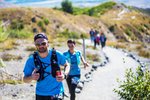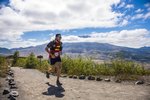

As I laced up my trail runners Saturday morning, Sept. 1, the sunrise glow cast a gold and purple hue on the clouds backdropping Mount St. Helens.
Tossing on a jacket against the morning chill, I wandered over and joined the scores of antsy runners milling about in the parking lot. As we drank coffee, stretched out and collected our race bibs, my eyes kept returning to the caved-in crest whose slopes we would be running in a few hours.
Backcountry Rise would be my first trail race, an induction to a sport I picked up shortly after moving to Washington this winter. Sometime in March, I set off on my first trail run, a three-mile jaunt up and through Seminary Hill above downtown Centralia. I labored up the switchbacks, stopping twice to catch my breath on a climb of fewer than 500 feet.
Before long, I’d learned to take the ascent on the road running up the backside of the hill, saving the steeper grades for my downhill return. I added the trails of Capitol State Forest to my repertoire, getting to know the six-mile loop that runs to Mima Falls.
By July, I’d joined the Oly Trail Runners, a friendly bunch that meets up for group runs on the trails in and around Olympia. I’d still never run more than 8 miles on a trail, but my new friends helped me learn how to build up mileage and set a sustainable pace. Many of them run 100-mile races regularly, but they were happy to share advice with the newbie in their midst over evening jaunts and post-run beers.
Before long, I’d decided to sign up for my first official race, and I couldn’t have chosen a better one. Backcountry Rise is a 20-mile loop in the Mount St. Helens National Volcanic Monument, mostly tracking along high, exposed ridgelines laid bare by the volcano’s 1980 eruption, with stunning views in all directions.
I spent the weekends leading up to the race getting in runs of increasing mileage. Eleven miles on Tiger Mountain wiped me out and made me wonder if I’d be ready in time. A dozen more on Cougar Mountain left me with similar weariness and doubts. I found my stride running two laps of the Mima Falls loop, then found my legs were up for the climb up Rock Candy Mountain.
Before I knew it, I was running 16 miles on the Pacific Crest Trail north of Stevens Pass. Finally, I knocked out my first 20-miler on an absolutely stunning route to Mount Gladys in the Olympics. I refilled my water bottles in icy-cold streams, ran through wildflower-filled meadows and accidentally chased a fat bear on my descent from the summit. This, more than my race time on a leaderboard, was why I’d chosen trail running.
Still, as Backcountry Rise approached, I wondered — would I measure up? Most of the other runners would be veterans of far longer distances. I knew the race’s 5,000 feet of climbing would force me to hike the steepest sections, which seemed like a failure even as I realized that the most elite trail runners take their climbs at a hiking pace.
A few weeks before the race, wildfire smoke set in across the region, and some of the weekly group runs were called off. The penultimate weekend, I was mostly inactive, allowing my body to rest up while spending time with a friend visiting from out of town. I revisited Seminary Hill the Monday before the race, charging up the switchbacks that had stymied me just a few months before. Still, my legs felt tight, and it seemed like the circumstances of the past few weeks had cost me my running rhythm and momentum.
I slept in my car Friday night, getting up early to give my well wishes to some friends who were running the 50-kilometer version of Backcountry Rise. After they set off, I got ready for my own race. I stretched out, filled the water bottles in my vest and scarfed down snacks in preparation for the thousands of calories I’d be burning.
Before we started, I tracked down Jeremy Long, the race’s organizer, to ask him about what I was in for.
“These are considered intermediate to advanced courses,” he told me. “There are a handful of beginners who are running it, but they’ve been forewarned to its ruggedness and exposure and remoteness. It’s more or less wilderness.”
When we finally got underway at 9 a.m., I ran through the starting line near the back of the pack, growing antsy as the 160 or so runners bottlenecked on the singletrack trail. We advanced in stops and starts, hugging the shore of Coldwater Lake for about the first five miles of the race. Despite the sluggish progress, I was surprised when we reached the first aid station. On the mostly flat terrain, it didn’t feel like I’d yet done five miles.
I earned my mileage after that, as the trail immediately began a five-mile ascent, winding higher and higher as it zigzagged up into the exposed ridges. Climbs like this had been discouraging when I started trail running. I’d assumed that runners were in good enough shape to run the entire course. Eventually, I’d learned that even the athletes at the top of the sport hike the big mountain climbs on courses like this.
If there’s one thing I can do, it’s hike. Last year, I thru-hiked the Pacific Crest Trail and its 2,650-mile path from Mexico to Canada. In the Sierra Nevadas and the Cascades, I’d grown used to climbs of thousands of feet, always with a full pack on my back. The punishing ascent that defined this run was just like dozens of others I’d done on the PCT.
As we made our way from 2,500 feet to 3,000 to 4,000 to 5,000, I found more and more runners moving aside to let me pass. I may not yet be a seasoned trail runner, but I can hike uphill with anybody. With each pass, I was greeted with a friendly “good job!” or “you’re killing it!” Trail runners are a driven, competitive bunch, but for most athletes, the competition is with themselves.
“Everyone has the same attitude about being optimistic and laid back about everything,” Long had told me as we mingled with the other colorfully-clad runners before the race. “We’re here to enjoy the outdoors, and that’s the primary focus, is being in a beautiful place and sharing it together with each other. There’s a lot of camaraderie, just unspoken in the trail running community. There isn’t that hard edge of competitiveness you see in other sports. It’s a warm-hearted sport.”
That attitude was on display as we came above the treeline and trotted along in collective awe at the views before us. Coming around a corner, we found the trail tracing a long path along an exposed ridgeline before topping out at a saddle. I watched the tiny dots of color of runners far ahead make their way up and over, disappearing on the other side. When I reached the divide myself, I hung a left and tracked another ridgeline to an even higher pass.
A familiar voice called out as I reached the new overlook. My girlfriend Mandy joined me for the weekend to get some backcountry adventure of her own, and her path to the summit of Coldwater Peak — and some fortuitous timing — allowed us to intersect and cheer each other on. I said hello as we looked down on St. Helens Lake, moving fog shrouding and then revealing the slopes ahead.
I carried on as the trail clung to the spine of the ridge, crisscrossing over the top to offer up a new view on each side. The top of Mount St. Helens rose above a low-lying cloud, the slopes below it strewn with thousands of matchsticks — the trees destroyed by the eruption decades ago. I weaved among the craggy spires of rock, then down through a natural archway opening in the mountainside.
By now, the long line of runners had thinned out. Ruddy bushes colored the mountainside in early autumn hues. Below, we could see the trail extending far into the distance, a thin line following Harrys Ridge above the shore of Spirit Lake, its deep blue waters populated with acres of floating timber.
We stopped frequently to take pictures, happy to sacrifice some pace and time to capture the scenes. Backcountry Rise, Long told me, is named for this landscape, for the literal up-from-the-ashes regrowth of the flowers and trees that have taken hold here, beginning the long march back to mature forest.
“The views are just one-a-kind because of the recovering blast zone,” he said. “Nature created an enhanced viewing area. The views are extensive in every direction for the majority of the course. … By the time you get back, it feels almost overwhelming that there’s so much around, because you’ve been used to pure silence. You see more mountain goats than humans when you’re out there.”
The naked landscape added to the isolation, vast panoramas empty of humans, save a few flashes of color moving steadily on the thin sliver of trail in the distance. After miles of backcountry views, we found ourselves crossing paths with day hikers as we neared the more populated — if no less scenic — Johnston Ridge. Fourteen miles in, we made our way to the second aid station for water, food and a much-needed port-a-potty. Hikers let us by and cheered us on as we passed.
As we went into the home stretch, the trail meandered over humpback ridges, its path still visible far in the distance. We ran through the hummocks, strange mounds that blew off St. Helens during its eruption and settled on this slope. Finally, we descended into a forest of young alder trees, trading the exposed views for the sound of the wind singing through the leaves, for verdant signs of life in an area once decimated.
Before long, the trail again wound along the shore of Coldwater Lake, and I braced for the final 500-foot climb to the finish line that I knew was just ahead. By now, my calves were tight and heavy, and I’d lost the spring in my gait. I trudged, lead-legged, as the trail steered upward. Thankfully, the other runners nearby were equally beat, and we commiserated as we took on the painstaking ascent.
As the sky began to appear over the top of the hill, I heard the cheers of spectators at the finish line and found a final burst of energy. Four and a half hours after I’d started, I finished the 20-mile course. I was spent.
After accepting congratulations from race organizers and volunteers, I hobbled into the Mount St. Helens Science and Learning Center and flopped down on the carpet. Mandy, fresh off her own mountain summit scramble, joined me soon after, laughing at my haggard appearance.
“The face of a champion,” she said.
Another runner, equally spent, appreciated that sentiment.
“She’s a keeper,” he told me.
I nodded my affirmation, then returned to my prone posture with various grunts and moans.
Trail running, they say, is a peculiar addiction, an assault on the body’s pain and exhaustion thresholds, offset by an endless supply of endorphins and stunning vistas. It’s miserable enough to make you question your sanity, exhilarating enough to make you do it all over again. As we drove back Saturday afternoon, I sat stiffly in the passenger seat, legs throbbing, grinning as I replayed the race in my mind. My trail runners, I know, still have a lot of mileage left.